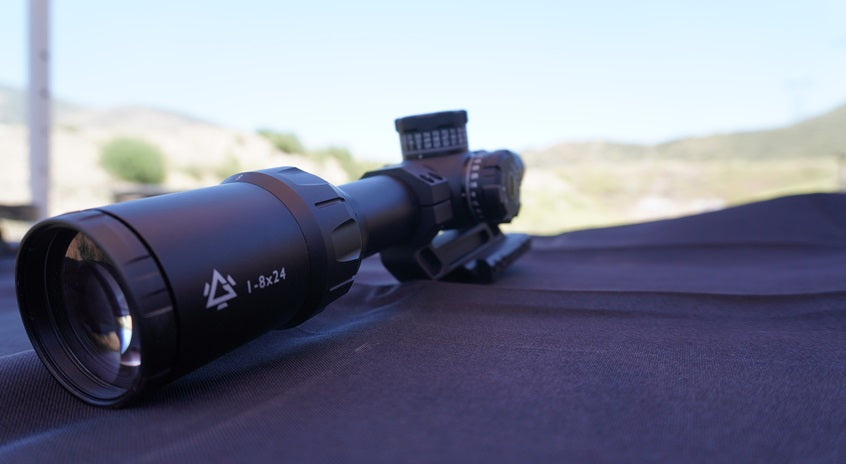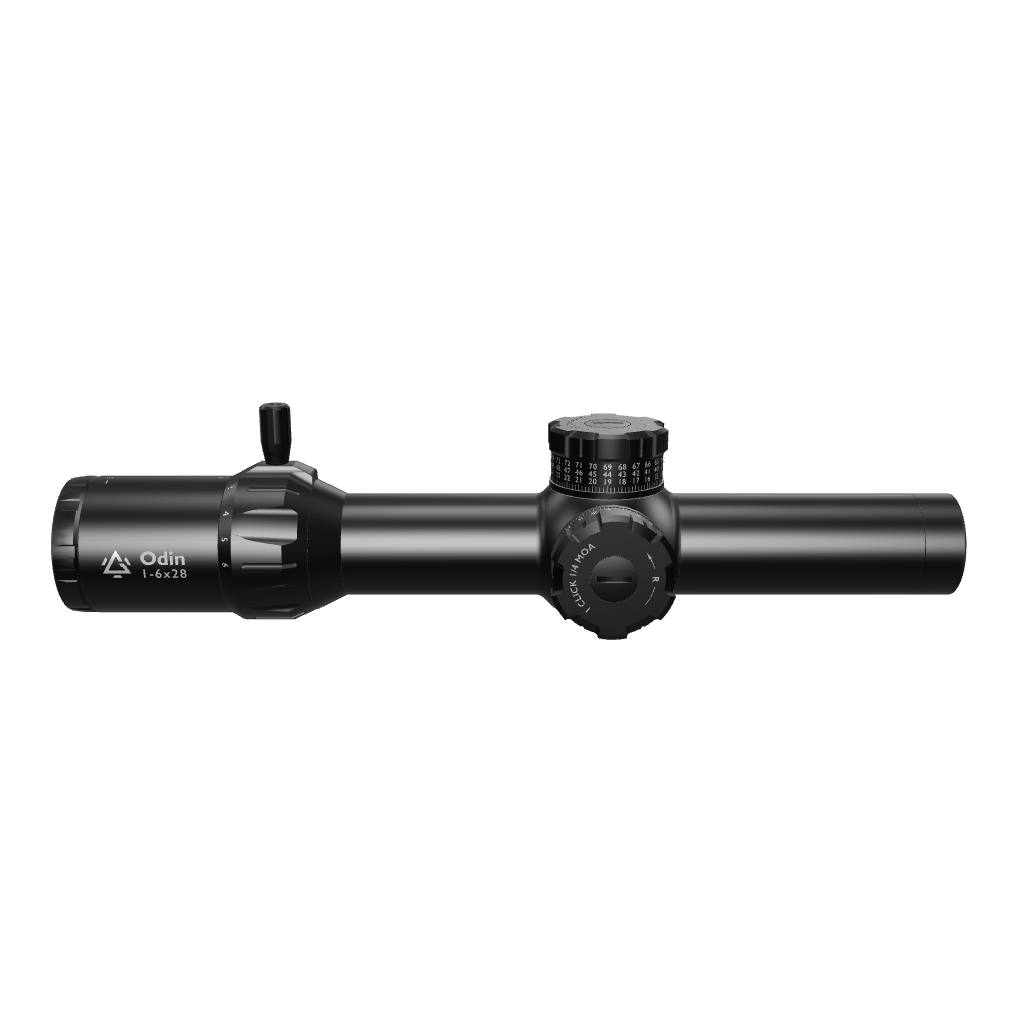FFPS VS SFPS: KEY DIFFERENCES EXPLAINED
LPVOs offer two reticle designs: First Focal Plane (FFP) and Second Focal Plane (SFP) reticles. Both types have their unique advantages and applications, and are suitable for different shooting needs, but what is the crucial difference between them?
What is the difference between an SFP reticle and an FFP reticle? The differences can be seen across reticle scaling, use cases, complexity and cost, and ease of use.
A lot of people can simply not explain this. Let’s make it simple.
1. RETICLE SCALING: THE CORE DIFFERENCE
The crucial difference between FFPs and SFPs is the location of the reticle. In an FFP, the reticle is located in front of the magnification lens system, and in an SFP, the lens in located behind the lens system. This fundamental difference is crucial because it determines how the reticle reacts as you go from higher to lower magnification or vice versa.
FFPs: MAGNIFICATION CHANGES, THE RECTICLE SIZE CHANGES
Because the reticle is positioned in front of the magnification lens, it scales with the magnification level. In other words, as you increase magnification, the size of the target gets bigger through the reticle, and the size of the entire reticle gets bigger too (you are looking through it, we’re assuming).
The major advantage of this system is that the reticle’s subtensions (like mils or MOA) remain consistent relative to the target, no matter the magnification. What that means is, that you see the target increase in size through the optic, but does not take up extra space because the size of the reticle is changing proportionally. The dimensions remain consistent. With a FFP, you get a clearer, bigger picture of the target through the reticle without sacrificing the accuracy of your estimates for bullet drop compensation, and holdovers. This data is available and reliable across all magnification settings.
LET’S TAKE AN EXAMPLE!
Let’s say your FFP scope has a reticle calibrated for 0.1 mil adjustments. These adjustments remain constant even as you adjust from 1x to 6x. At 6x, you get a clearer view of your target, and your adjustments remain intact as they were at 1x. This explains why FFPs are a favorite in the military where shooters have to adjust to dynamic scenarios and shoot over variable distances without losing accuracy.
SECOND FOCAL PLANE: MAGNIFICATION CHANGES, RETICLE SIZE REMAINS THE SAME
In an SFP scope, the reticle is positioned behind the magnification system and so its size remains constant as you change magnification levels. At high magnification, the target becomes bigger, the reticle stays the same. At lower magnification, the target becomes smaller, the reticle stays the same.
What does this mean for the dimensions? Well, the subtensions are accurate only at a specific magnification setting (usually at the highest magnification). If the reticle is calibrated for 6x magnification, you will have to adjust the windage and elevation anew if you shift to lower magnifications, for example. The dimensions do not stay the same.
Admittedly, this seems like a huge limitation. However, SFP optics are perfect for people who use their rifles for a single purpose at a fixed magnification level.
2. USE CASES: MATCHING SCOPE TO PURPOSE
Another factor to consider when choosing is what you intend to use your optic for. Both perform really well in a variety of situations, but we are talking about ideal use: situations in which a FFP would serve you better than a SFP, and vice-versa.
FFP LPVO: ACCURACY IN DIFFERENT SCENARIOS
If you are going to be primarily engaged in shooting scenarios where you have to maintain accuracy while engaging targets at varying distances, then an FFP is the way to go. Obviously, this covers a really wide range of shooting activities: from tactical applications to long-range shooting and everything in between. All you have to do is ask yourself the question: “Do I have to use my reticle at different magnification levels?”. If yes, then you probably need a FFP.
SFP LPVO: ACCURACY IN THE RIGHT SCENARIO
Choose an SFP on the other hand if you constantly shoot at a specific magnification setting, or if the “behavior” of the reticle really makes no difference to you. Some people primarily shoot at a single magnification (say 6x for example), and so the SFP scope’s constant reticle size might be all they need.
SFP scopes are also simpler to use and relatively less expensive. They are a favorite for people who shoot for recreational purposes or hunt in areas where the terrain is pretty familiar and predictable.
3. COMPLEXITY AND COST: WHAT TO EXPECT
Now, let's discuss cost in more detail. Both FFP and SFP optics are complex to design and manufacture, and this explains why they are both usually on a higher price. But they do not cost the same, and (especially in the current economy), that is important.
FFP LPVO: VERSATILITY, BUT AT A GREATER COST
FFP optics are more technically demanding and complex to design and achieve. Achieving that precise reticle scaling at different levels of magnification is costly to achieve and this complexity translates to a higher price point.
Also, FFP scopes usually feature more intricate reticle designs to maintain the integrity of the reticle even as it expands or constricts in size. The result is that they end up requiring rare and high-quality components which are often more costly to assemble.
SFPs LPVOs: CHEAPER, MORE SIMPLE
By comparison, SFP scopes are generally simpler in design as the reticle doesn’t need to scale with magnification. Simplicity means lower production and assembly costs, and consequently more affordable prices. To some shooters, reliability is most important, and they often do not think it worthy to spend so much more for the added features of an FFP. If you fall within this category, then an SFP is the optic for you.
However, what matters most at the end of the day is value for money. Where do your shooting priorities lie, and what matters most to you? Users of FFPs argue that the increased versatility and functionality of their scopes are totally worth the extra expenses because that is what matters to them. For users of SFPs, they can get what they want without spending much. So, the conversation about the prices of LPVOs should really start with what matters to you as a shooter.
4. EASE OF USE: HOW QUICK CAN YOU MASTER THE OPTIC?
If you are a beginner, then you want to get as comfortable with your optic as possible within the shortest possible time. Things are easier if the optic is easier to use. First, we must note that an optic being easier to use does not mean we have to do away with any safety precautions. The conversation is about how complex the scope is to master. So, which is easier to use?
FFP LPVO: TAKES MORE TIME
FFP scopes offer the advantage of having the reticle’s measurements always accurate relative to the target size, but they do come with a learning curve. You need some time and constant practice to become familiar with how the reticle’s subtensions change with magnification and how to utilize these features effectively. However, this should not take forever, and once you master it and can shoot accurately in different scenarios, you will be grateful you had to go through the process.
SFP LPVO: EASIER TO MASTER
SFP scopes are often simpler to use for shooters who stick to a fixed magnification setting. If the reticle size is constant, and you generally shoot at the same level of magnification, there is no need to go into learning the specifics of playing with variable magnification. If your shooting style involves using consistent magnification, an SFP scope might offer a more straightforward and user-friendly experience.
5. BRIGHTNESS AND CLARITY: WHAT TO EXPECT
Typically, you should be able to see your target bright and clear irrespective of the LPVO you are using. However, there might be some slight differences, especially in the case of FFPs when you are changing magnification. Let's explore.
FFP LPVO: CLEAR MODERN DESIGNS
In FFP scopes, the reticle is part of the image plane, and so it was previously common to notice a slight reduction in clarity at higher magnifications. However, this is really no longer a problem. Modern FFP scopes are designed with improved optics to minimize these issues, ensuring that the image remains clear and bright.
GUNNR, for example, a newly launched brand of LPVOs and rifle accessories tested over thirty different types of glass from top companies all across the United States, Canada, and Europe for their rifle scopes. Finally, it settled on German glass which performed impeccably during the tests, providing clear and crisp images even across long ranges. With improvements like these, clarity is no longer an issue for most modern FFPs
SFP LPVO: ALWAYS BEEN CLEAR
It also used to be the consensus that SFP scopes offer slightly better image clarity and brightness, particularly at lower magnifications since the reticle size remains constant, and there’s less potential for interference with the image quality.
However, this depends on which models you are using. If you get modern optics such as GUNNR’s ODIN Scopes, you should be fine.
GUNNR’S ODIN SCOPES?
Gunnr’s Odin 1-6x28 LPVO is the newly released line of scopes from GUNNR, a company that is quickly gaining ground with its high-quality optics that offer you the perfect blend of innovation and reliability at a price that won't break the bank.
With Odin scopes, you experience the superior clarity of German Schott ED Glass, ensuring exceptional edge-to-edge sharpness for every shot.
The first focal plane (FFP) reticle provides fast, accurate distance estimation at any magnification, adapting seamlessly to changing light conditions with six brightness settings. These optics are Constructed from durable 7075 aluminum alloy, this scope is IP67-rated for dust and waterproof performance, guaranteeing dependability in any environment. With the Gunnr Odin, you're equipped with a versatile tool designed to enhance your shooting experience and leave you wondering how you ever aimed without it.







